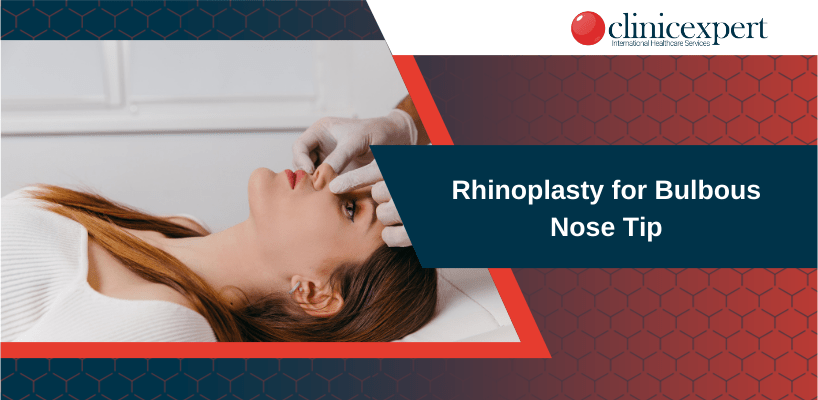Rhinoplasty for Bulbous Nose Tip: Everything You Need to Know
Your nose is one of the most prominent features on your face. Unfortunately, a bulbous tip can significantly affect your overall appearance. A bulbous nose tip is characterized by a rounded, wide, and disproportionate tip that can make your nose look unbalanced and detract from the harmony of your facial features. Fortunately, a rhinoplasty can effectively address a bulbous nose tip and improve the appearance and functionality of your nose.
Reshaping the cartilage and refining of the bulbous nose tip are two techniques that rhinoplasty surgeons perform. To get started today or learn more about the surgery, you can easily request a consultation via Whatsapp.
What Causes a Bulbous Tip?
Bulbous tips are mostly caused due to misshaped cartilages. In some cases, the cartilage may be overly round or bulbous, leading to a less defined nasal tip. If your family members have a bulbous nose tip, you may be more likely to develop one as well. Another common cause of a bulbous nasal tip could be the thickness of the nose skin. This is usually the case with the ethnic rhinoplasty patients. When the skin is thick, it can mask the underlying nasal structures, making the nose appear less refined.
A bulbous nose tip could also caused by a previous trauma. Trauma to the nose, such as a broken nose, can alter the shape and structure of the nasal tip, leading to a bulbous appearance. Lastly, aging could be a factor for a bulbous nasal tip. As we age, the skin and soft tissues of the nose may begin to lose elasticity and firmness, leading to a less defined nasal tip.
What Is a Bulbous Nose Surgery?
Bulbous nose tip rhinoplasty involves reshaping and refining the nasal tip to achieve a more proportionate and aesthetically pleasing appearance. The specific technique used will depend on the unique features of the patient’s nose and their desired outcome. However, generally, there are two primary approaches: open and closed rhinoplasty.
Thick Skin Rhinoplasty Techniques for a Bulbous Nose
Open rhinoplasty requires a small incision on the thin strip of tissue that separates the nostrils. The surgeon lifts the skin to access the nasal structures, allowing direct visualization and manipulation of the nasal tip cartilage. This technique facilitates precise changes to be made to the nasal tip.
On the other hand, closed rhinoplasty involves making all incisions inside the nostrils. The surgeon then works through these openings to access the nasal structures. This technique is less invasive and has a shorter recovery time. However, it may be more challenging to achieve significant changes to the nasal tip with this technique.
During the procedure, the surgeon may use a variety of techniques to reshape the nasal tip, such as removing excess cartilage, sculpting the remaining cartilage to create a more defined shape, and adding structural support with grafts. For patients with thick skin, additional techniques may be necessary to address the excess tissue and create a more refined appearance.
After the surgery, patients typically wear a splint on their nose for about a week to protect and support the healing tissues. Swelling and bruising are common in the first few weeks after the procedure, but most patients can resume normal activities within two to four weeks. It’s essential to follow all post-operative instructions carefully to ensure a safe and successful recovery.
The Bulbous Nose Job: Is It Right for You?
It’s essential to understand the potential benefits and risks of the procedure. It is only way to determine if it’s the right choice for you. Some factors to consider include:
The severity of your bulbous nose tip: Rhinoplasty can effectively address a wide range of nasal tip concerns. But the more severe the issue, the more challenging it may be to achieve a satisfactory outcome.
Your overall health: Like any surgery, rhinoplasty carries some degree of risk, so it’s crucial to be in good health before undergoing the procedure.
Realistic expectations: While rhinoplasty can significantly improve the appearance of a bulbous nose tip, it’s essential to have realistic expectations about the results. Your surgeon can help you understand what’s achievable and what isn’t.
Recovery time: Rhinoplasty typically involves a week or two of downtime, during which you’ll need to avoid strenuous activities and follow your surgeon’s post-operative instructions carefully.
Ultimately, the decision to undergo rhinoplasty is a personal one. Therefore, you should be careful. Be sure to consider of all the factors involved. If you’re unsure if the procedure is right for you, schedule a consultation with a qualified plastic surgeon to discuss your options and determine the best course of action. You can contact us via WhatsApp or by filling out our patient form right away.
Recovery and Aftercare for Bulbous Nose Surgery
The recovery time for a bulbous nose tip surgery can vary depending on the extent of the procedure, However, we can say that general recovery time after the surgery is around seven or eight days. Most patients can expect to experience some swelling, bruising, and discomfort in the days and weeks following surgery.
During the first week after surgery, you will need to wear a splint or cast on your nose to help support the healing tissues and protect your nose. You’ll also need to avoid strenuous activities or any activity that could impact the nose, such as blowing your nose or wearing glasses.
You’ll gradually begin to see the results of your surgery as the swelling and bruising subside. However, it can take up to a year for the final results of your surgery to become fully apparent.
Most patients can return to work and other normal activities within two to three weeks at maximum. However, it’s essential to follow your surgeon’s post-operative instructions carefully to ensure the best possible outcome and avoid any complications.

